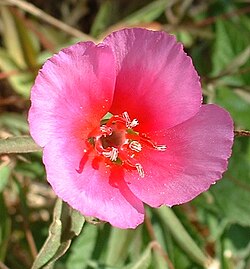| Clarkia amoena | |
|---|---|
 | |
| Scientific classification | |
| Kingdom: | Plantae |
| Clade: | Tracheophytes |
| Clade: | Angiosperms |
| Clade: | Eudicots |
| Clade: | Rosids |
| Order: | Myrtales |
| Family: | Onagraceae |
| Genus: | Clarkia |
| Species: | C. amoena |
| Binomial name | |
| Clarkia amoena | |
| Synonyms [1] | |
| |
Clarkia amoena, commonly known as farewell to spring, godetia, or satin flower, is a species of flowering plant in the family Onagraceae . [1] [2] It is native to western North America. It is found in coastal hills and mountains from British Columbia south to the San Francisco Bay Area of California.
Contents
This annual herb produces showy pink to lavender flowers and is known for its late spring to early summer blooming period. The species was formerly classified in the genus Godetia, and is still sometimes referred to by the synonym Godetia amoena.
















